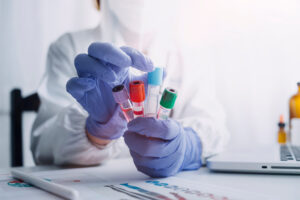A Wellness Trend with Enormous Economic Implications
Living to be 100+, but looking, feeling, and thinking half, or even a third that age is the premise behind one of the hottest trends in wellness today. And rightfully so! Between 1990 and 2021, the time Americans spent in good health (healthspan) dipped from 64.8 years to 64.4 years, while life expectancy (lifespan) increased from 75.6 years to 77.1. This rising gap carries significant economic ramifications as the cost of treating the diseases/disabilities associated with aging outweighs the benefits of slowing aging itself down. The race to find the so-called fountain of youth is thus on, (literally – XPRIZE Healthspan), and it holds promise for more than just a few billionaires trying to biohack their own immortality.
Multi-disease vs Single-disease: The Shift in Thinking Involved
Healthcare has traditionally focused on treating or curing one disease at a time (“sickcare” in other words). This reactive approach addresses disease separately, without considering how multiple health conditions might be connected. However, as we age, we often develop multiple illnesses simultaneously, and treating each separately can be extremely complex, costly, and often does not address the underlying causes contributing to an overall decline in health.
Proactively treating or slowing aging (preventative care) is a multi-disease approach, targeting biology rather than a single illness, and the key to improving healthspan-lifespan, or as some say, a move to true healthcare.
Today’s established medical paradigm of one disease, one drug, then choosing patients for a clinical trial that only have that one disease does not match reality. The shift to a multi-disease approach thus requires everything from study designs to drug approval processes to be modernized to address the complexities of proactively treating aging and moving discoveries from the bench to clinical care and health policy.
Fortunately, many pioneers are paving the way for this new approach to aging.

A Sampling of Organizations, Institutions, and Biotechs Advancing the Multi-Disease Approach to Aging
Longevity and Anti-Senescence Therapy
The market was valued at USD 27.11 Billion in 2023 and is predicted to reach USD 44.92 Billion by 2031 at a 6.8 % CAGR during the forecast period.
While the market is categorized on the basis of therapy and application, those funding, and often initiating the investigations, in addition to the biotechs commercializing the therapies, are acknowledged here to aid in understanding the broader landscape. The below are just a sampling of the innovators in this area.
The Alliance for Aging Research, a non-profit patient advocacy group, focuses on changing the narrative surrounding aging from one fraught with misconceptions, prejudice, and stigma to one focused on opportunities and challenges. The Alliance has guided efforts to substantially increase funding and focus for aging at the National Institutes of Health and Food and Drug Administration, and has built influential coalitions to guide groundbreaking regulatory improvements for age-related diseases.
The Buck Institute is the first independent biomedical research institute focused solely on intervention in the aging process. It reframes aging as a malleable phenomenon, rather than an irrevocable descent, and since its founding in 1999, has shed light on the molecular mechanisms underlying aging, identified potential interventions, and inspired a new era of research and discovery.
Altos Labs, launched in 2022, is a biotechnology company focused on cellular rejuvenation programming to restore cell health and resilience. Comprised of prominent scientists, clinicians, and leaders from academia and industry, Altos is working to prove that the cellular dysfunction associated with aging and disease is reversible (can be reprogrammed or optimized). Currently, all investigations at Altos are preclinical.
Cambrian Bio, a drug development company, focuses on creating medicines that target “the drivers of aging”. They first develop treatments for specific age-related diseases, then as preventative medicines. Operating as a distributed company, Cambrian is capable of advancing multiple pre-clinical studies at once, tackling age-related diseases from various angles, giving them a significant chance of getting at least one past initial safety and efficacy hurdles, and thus allowing them to begin building a clinical platform for the treatment of aging immediately. Cambrian currently has about 20 drugs in the pipeline.
BioAge Labs, a Cambrian Bio PipeCo that has traditionally tackled diseases inherent to aging, has changed direction somewhat due to the current GLP-1 boom, and its recent fundraise, so will most likely look to partner on the further development of its investigation into NLRP3 inhibitors that BioAge believes could address a range of neurodegenerative conditions driven by neuroinflammation associated with aging.

The Evolution of Psychedelics as Longetivty Therapies
While already proven (under the right conditions) in the treatment of trauma (PTSD), substance use disorders (SUDs), and depression, research on psychedelics is now exploring the impact these substances may have on stimulating nerve cell regrowth in parts of the brain responsible for memory.
The Longevity Science Foundation (LSF), a global nonprofit dedicated to making longevity-related treatments and therapies accessible to everyone, not just the highly educated and privileged, in partnership with PsycMed Ventures, a venture capital firm that focuses on investing in frontier technologies that aim to elevate mental health and wellness, created a $25 million fund for research into existing or novel psychedelic applications to manage, delay or reverse age-related mental and brain diseases.
Eleusis, a life science company dedicated to “transforming psychedelics into medicines”, has published findings from its extensive preclinical work on neurodegenerative diseases showing LSD’s therapeutic potential for the cognitive decline associated with Alzheimer’s disease by modulating serotonin and dopamine receptors.
Pseudo Science or Cutting Edge Healthy Aging Concepts?
Personalized Medicine
The global market was valued at USD 578.21 billion in 2023 and is expected to reach over USD 1,233.23 billion by 2033, poised to grow at a notable CAGR of 8.10% during the forecast period. There are several distinct segments within the personalized medicine market (e.g., diagnostics, therapeutics, medical care, and nutrition and wellness), all of which often intersect one another, as well as other sectors (e.g., financial systems, policy, etc.) adding yet another layer to unraveling aging’s complexity. Here the focus will be centered on one model of medical care.
Longevity Clinics
Longevity clinics emphasize proactive care to slow aging and provide patients with a plethora of services ranging from beauty treatments such as Botox, diagnostic and biomarker testing, diet and nutrition counseling, exercise regimes, and sleep optimization, to IV, supplement, and drug treatments (none of which are FDA approved for the treatment of aging), and even less proven interventions such as stem cell therapies and young plasma treatments. The idea is to get a full picture of how well your body functions—and what could be done to improve things.
Young Blood
| Blood transfusions from young donors to older recipients to dial back the clock on aging have not been clinically proven to work in humans, and trials in this area are currently lacking because, as already noted, aging is not a specific disease.
This lack of evidence led the FDA to issue consumers a warning against clinics offering young blood treatments (which led to the closure of Silicone Valley darling Ambrosia), however, that has not stopped the practice. Resurgence Wellness, a longevity clinic probably most well known for having infused tech mogul Bryan Johnson with his son’s plasma), offers regenerative treatments, including young plasma, claiming it has been “proven to delay or reverse the aging process, boost energy levels, speed up recoveries from injuries and reduce adrenal fatigue, in patients with autoimmune disorders”. Longevity medicine is not officially recognized as a medical discipline, nor do longevity doctors have a standard of practice to follow, as there is no consistent definition of what exactly a longevity clinic is or does, but there is interest in legitimizing them. A brief profile of just a few demonstrates how diverse they can be. Human Longevity, Inc.’s Health Nucleus, positioned like most in this space as a precision healthcare system, has a team of world-class clinicians and genomic scientists who use technology to detect and preempt disease based on personalized data. Whole genome sequencing, blood-based biomarkers, whole body imaging, bone & muscle strength analysis, and nutrition & lifestyle habits are just some of the assessments used. Serotonin Centres, a US franchise with 15 locations (current or planned for now) in the southeast, integrates medical practitioners and health coaches in a concierge-style practice providing scientifically proven therapies for weight loss and control, hormonal imbalances, aesthetics, and immunity. Founded by fitness and franchise expert Eric Casaburi, Serotonin Centers was named after the hormone that works to stabilize overall feelings of well-being and happiness. resTOR Longevity Clinic, located in Houston, TX, uses biometric readings, genetic profiling, lifestyle choice assessments, and an in-depth medical intake by board-certified medicine physicians to create individualized health plans. Continuous monitoring aids in optimization over time. Domestic medical tourism is also implied for out-of-state clients through the clinic’s effortless travel process. |

Non-pharmacological Treatments and the Brands Augmenting Healthspan
Complementary and Alternative Medicine for Anti-aging & Longevity
The market was estimated at USD 63.60 billion in 2023 and is expected to reach USD 247.9 billion by 2030 at a 21.5% CAGR during the forecast period.
Many of the treatments available within this space focus on the beauty aspect of aging, only affecting how a person looks, however, it isn’t yet well-defined where wellness ends and longevity medicine begins. Consumer demand for these products and services, beauty and beyond, is skyrocketing (as evidenced by the projected market growth over the coming years), so it’s valuable to consider this sector when examining healthspan-lifespan.
OneSkin, founded by four female PhDs with expertise in stem cell biology, skin regeneration, bioinformatics, and aging, sells “topical supplements” (aka face cream) formulated with OS-01, the first peptide studied (using a molecular clock), to reduce skin’s biological age, making it a breakthrough ingredient for mature skin. The OS-01 peptide is believed to increase epidermal thickness, improving skin strength and visible signs of aging like crepiness, wrinkles, and skin fragility.
IonLayer NAD+ transdermal patches provide high potency at-home activation of NAD+, non-invasively (e.g., no IV), replenishing and increasing the bioavailability of NAD+ in the body. Restoring NAD+ levels is believed to have the potential to slow down and reverse many aging-associated diseases such as cognitive decline, cancer, metabolic disease, sarcopenia, and frailty.
Novos Lab’s longevity drink mix promises to maximize healthspan & lifespan potential by simultaneously addressing the 12 causes of aging through a stack of supplements recommended by Harvard genetics and aging scientist Dr. David Sinclair in his renowned anti-aging protocol.
Juvenescience’s Cognitive Switch drink mix induces ketosis within 30 minutes and maintains the state for several hours. Ketosis, the state where the body burns fat instead of carbohydrates, increasing the production of anti-inflammatory ketone bodies, is believed to be linked to longevity.
VO2 Master, a portable VO2 max analyzer enables testing in any environment without packs, hoses, or wires, providing lab-grade accuracy (even consumers can purchase it if they don’t mind shelling out ~$7K). VO2 max, or the maximum rate at which your muscles can extract oxygen from your blood and put it to metabolic use to generate energy, is believed to be an indicator of health and longevity.

Embracing a New Era in Aging
The landscape of aging is undergoing a profound transformation, driven by a shift towards remaining healthy longer vs simply living longer. This alteration is energizing growth in a number of areas, from research and drugs to healthcare and consumer products, bringing the proverbial fountain of youth nearer to reality than ever before.
Curious about extending your brand’s position within the healthspan/lifespan landscape? Let’s discuss your goals and challenges. Reach out to us at hello@migrationmarketing.com with the subject line: Blog Inquiry.
___________________________________________________________________________________________
About the Author
Carol Maggio is a Senior Consulting Strategist at Migration Marketing.
The author wishes to thank Anne Summa, Shantelle Wasag, and Sandy Chase for contributing to this article.

